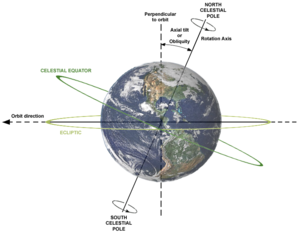
The celestial equator is the great circle of the imaginary celestial sphere on the same plane as the equator of Earth. By extension, it is also a plane of reference in the equatorial coordinate system. In other words, the celestial equator is an abstract projection of the terrestrial equator into outer space.[1] Due to Earth's axial tilt, the celestial equator is currently inclined by about 23.44° with respect to the ecliptic (the plane of Earth's orbit), but has varied from about 22.0° to 24.5° over the past 5 million years[2] due to perturbation from other planets.
An observer standing on Earth's equator visualizes the celestial equator as a semicircle passing through the zenith, the point directly overhead. As the observer moves north (or south), the celestial equator tilts towards the opposite horizon. The celestial equator is defined to be infinitely distant (since it is on the celestial sphere); thus, the ends of the semicircle always intersect the horizon due east and due west, regardless of the observer's position on Earth. At the poles, the celestial equator coincides with the astronomical horizon. At all latitudes, the celestial equator is a uniform arc or circle because the observer is only finitely far from the plane of the celestial equator, but infinitely far from the celestial equator itself.[3]
Astronomical objects near the celestial equator appear above the horizon from most places on earth, but they culminate (reach the meridian) highest near the equator. The celestial equator currently passes through these constellations:[4]
|
These are the most globally visible constellations.
Over thousands of years, the orientation of Earth's equator and thus the constellations the celestial equator passes through will change due to axial precession.
Celestial bodies other than Earth also have similarly defined celestial equators.[5][6]
YouTube Encyclopedic
-
1/3Views:125 40412 44722 495
-
Basics of Astronomy: The Celestial Sphere
-
Astronomy - Ch. 2: Understanding the Night Sky (8 of 23) Understanding Celestial Coordinates
-
Astronomy - Ch. 2: Understanding the Night Sky (2 of 23) What is the Ecliptic Plane?
Transcription
See also
References
- ^ "Celestial Equator". Retrieved 5 August 2011.
- ^ Berger, A.L. (1976). "Obliquity and Precession for the Last 5000000 Years". Astronomy and Astrophysics. 51 (1): 127–135. Bibcode:1976A&A....51..127B.
- ^ Millar, William (2006). The Amateur Astronomer's Introduction to the Celestial Sphere. Cambridge University Press. ISBN 978-0-521-67123-1.
- ^ Ford, Dominic. "Map of the Constellations". in-the-sky.org. Retrieved 1 Feb 2021.
- ^ Tarasashvili MV, Sabashvili ShA, Tsereteli SL, Aleksidze NG (26 Mar 2013). "New model of Mars surface irradiation for the climate simulation chamber 'Artificial Mars'". International Journal of Astrobiology. 12 (2): 161–170. Bibcode:2013IJAsB..12..161T. doi:10.1017/S1473550413000062. S2CID 120041831.
- ^ "Equal length of day and night on Saturn: the start of spring in the northern hemisphere". German Aerospace Center. Retrieved 1 Feb 2021.
